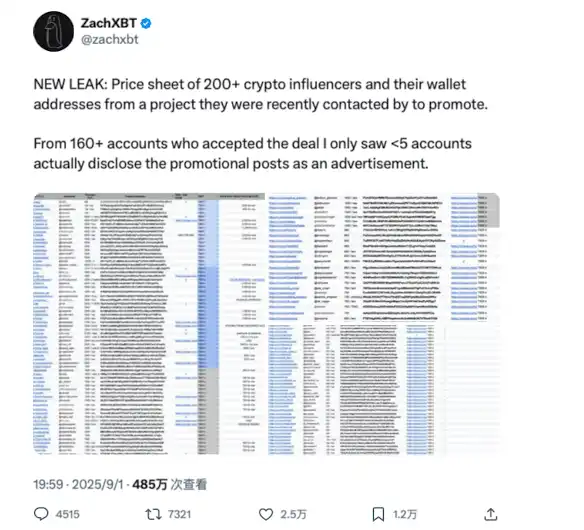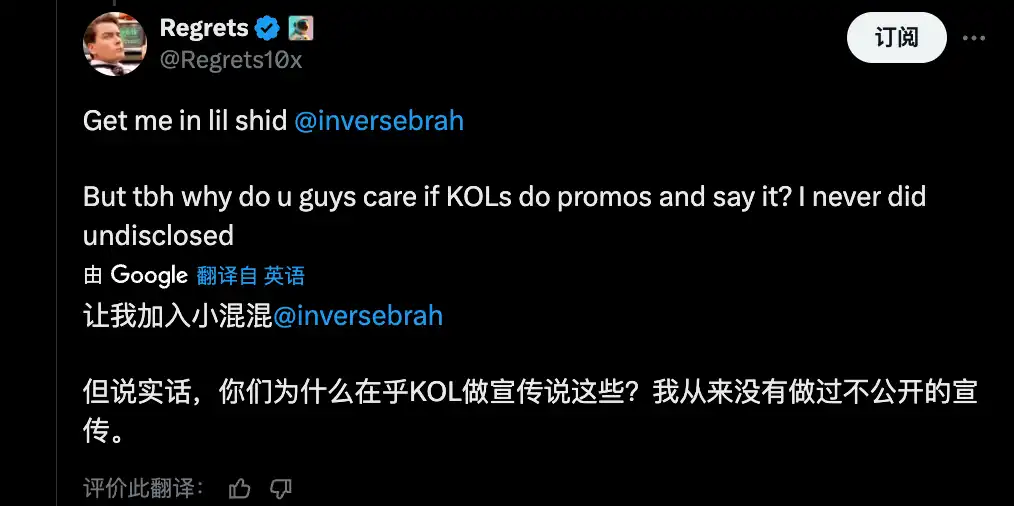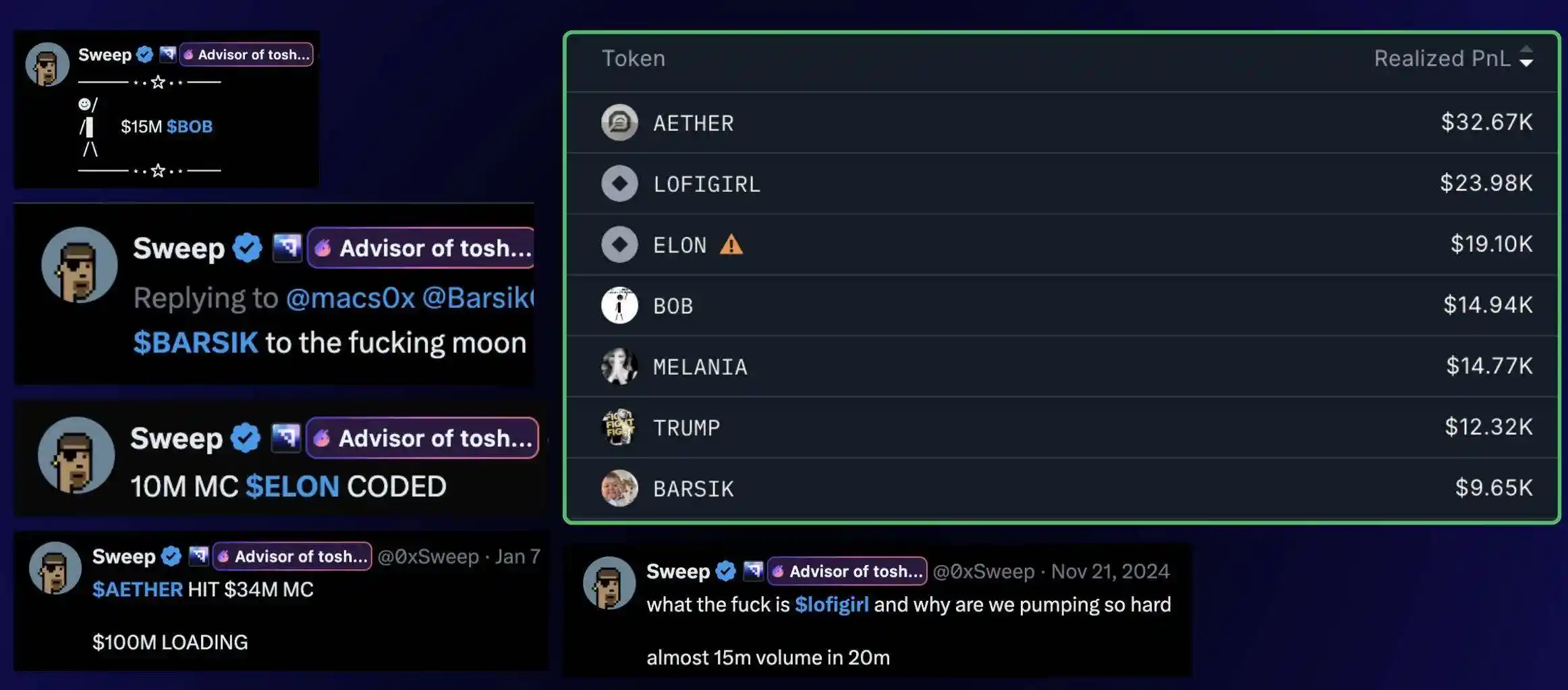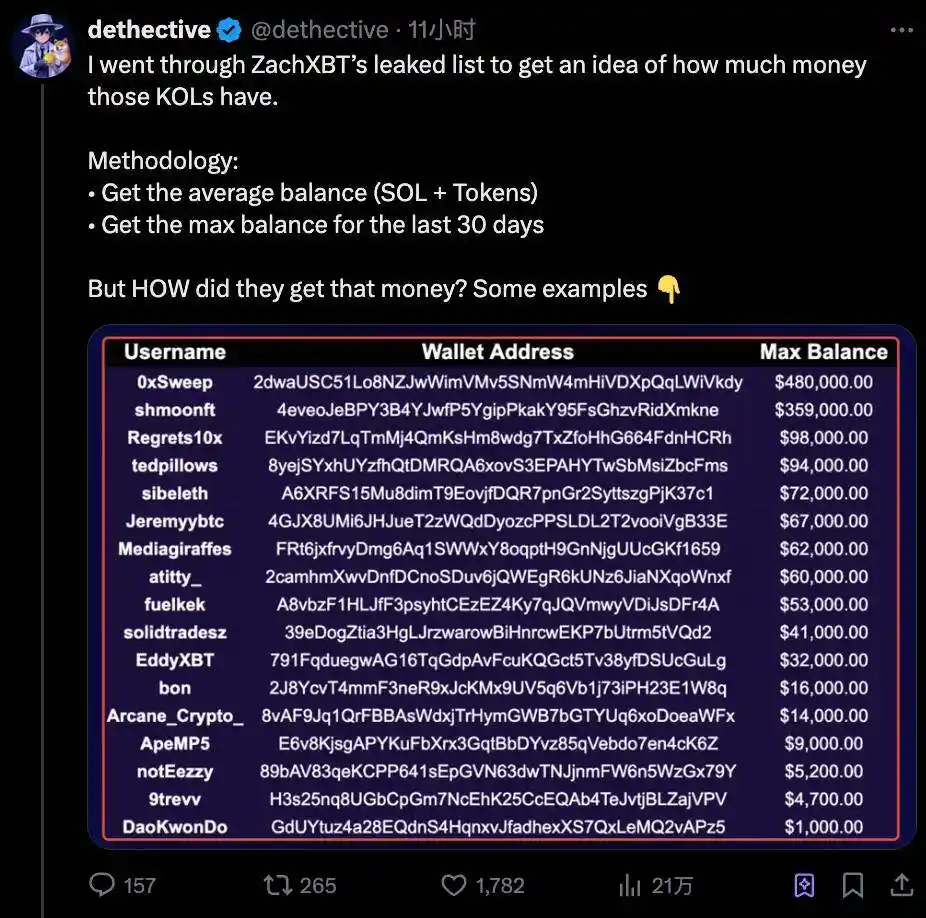Original Title: "Foreign KOL's Strategies for Harvesting Retail Investors: Clustering, Creating Momentum, and Concealment"
Original Author: San, David, Deep Tide TechFlow
On September 1, as the market's attention and liquidity focused on Trump's $WLFI, the well-known on-chain detective @ZachXBT began to expose new information.
He revealed a list of paid promotions by overseas KOLs, documenting the activities of several English-speaking KOLs promoting crypto projects on the X platform for compensation. The accounts involved were numerous, with total payments exceeding one million dollars; the price for a single tweet ranged from $1,500 to $60,000, depending on the KOL's influence.

ZachXBT pointed out that of the KOLs on this list, fewer than five accounts labeled their promotional posts with the word "advertisement," meaning that the vast majority of KOLs did not disclose whether their posts were paid promotions or purely spontaneous shares.
Subsequently, another small detective, @dethective, conducted further analysis and organization of the original table, discovering that these overseas KOLs had even more elaborate methods for paid promotions.
Multiple Accounts for One Person, Earning Twice from the Project
In @dethective's analysis, the first issue that stood out was the repeated appearance of some wallet addresses on the list.
This means that the same wallet may correspond to multiple KOL accounts, receiving promotional fees for the same project multiple times.

Taking the accounts @Regrets10x and @lynk0x as examples. The list shows that the former received $8,000 for four posts, while the latter received $12,000 for the same number of posts, likely due to the differing follower counts of the two accounts.
However, their wallet addresses are identical:
EKvYizd7LqTmMj4QqmKsHm8wdg7TXzFoHHg664FdnhCRh
After cross-referencing, blogger @dethective found that there were about 10 similar cases of repeated wallets throughout the entire list.
One possible reason is that some overseas KOLs, in order to expand their influence, use secondary or associated accounts for promotions without changing wallet addresses, leading to exposed traces;
But upon deeper reflection, not changing wallet addresses, whether due to laziness or negligence, actually reflects a clustering strategy, where multiple accounts posting about the same project more easily occupy social media timelines and attention, thereby triggering FOMO among fans.
Of course, the two KOLs exposed were not idle either.
@lynk0x denied receiving any payment in the comments, stating that @Regrets10x was just a friend and that sharing the wallet was purely coincidental. But @dethective quickly presented evidence:
The aforementioned wallet received $60,000 from an airdrop from a project called "Boop," and to claim the airdrop, one must bind an X account. This indirectly proves the control relationship between the account and the wallet, making the denial somewhat untenable.
@Regrets10x's response was more casual; he did not directly address the accusations but stated that as long as he disclosed the paid promotion when posting, there was no problem;

Accepting paid promotions is understandable, and appropriate disclosure helps others understand the motivations and interests behind the posts. Some more professional KOLs often add a note like "related interests" or "unrelated interests" at the end of a post.
But the problem lies in the fact that if two accounts belong to the same person, and one account openly reminds followers that the content is an advertisement while the other remains silent, it resembles a strategy for creating a persona through an account matrix.
Moreover, some have turned the practice of mass account promotions into an industrial chain.
Previously, research organization DFRLab published a study titled "Analysis of Crypto Scams on Twitter," which mentioned that certain gray market operators could control dozens of accounts, posting nearly 300 tweets daily, creating false public recognition through bulk account nurturing, automated retweets and replies, and cross-endorsement.
Operators typically acquire old accounts or register new ones in bulk, change the nicknames and avatars, and become a brand new KOL, then use scripts to copy the same promotional language into the comments of high-traffic tweets to "gain followers."

"To The Moon"
After the list was exposed, another noteworthy point was that the profits from these overseas KOLs' wallets often highly overlapped with the tokens they promoted.
In other words, they were not casually sharing "insights" but were first given tasks, and after promoting, they also engaged in trading themselves.
For example, the account @0xSweep, in @dethective's wallet analysis, showed that his largest profit sources were several tokens on the BullX trading platform: $AETHER, $BOB, $BARSIK, etc.
However, the backstory is that these tokens all had records of paid promotions on the list exposed by ZachXBT; and @0xSweep's X posts repeatedly mentioned them, believing they had great potential and were "to the moon."

But his wallet records show that these profitable trades occurred just before and after the promotions, likely indicating that the project paid him to post, and after he posted, the token gained popularity, allowing him to trade.
This also means that if an account keeps telling you about their trading insights, their income may not come from trading and market judgment.
A similar situation exists with @ShmooNFT. His Telegram channel promotes about 10 tokens daily, seemingly enthusiastic in sharing.
However, wallet tracking shows that his few profitable trades, such as $DEGE, $BON, and $BOTIFY, all had promotions on X and appeared on the earlier list exposed by ZachXBT.

The core issue with this model is that the KOL's "advice" carries hidden interests: promotional posts not labeled as advertisements lead fans to believe they are genuine recommendations, when in fact they are paid collaborations.
If the tokens indeed have potential, everyone benefits, but if the promoted tokens continuously drop to zero, the KOL's credibility and influence will also decline.
The cleverness of this scheme lies in the fact that these overseas KOLs may earn threefold.
First, they obtain free tokens through airdrops, then charge the project for promotional fees, and finally sell the airdropped tokens after inflating the price through promotions.
Additionally, a common advanced tactic is to build a "trading god" image by showcasing profits from trades, then establish paid groups to collect "membership fees."
Where There’s Demand, There’s a Market
At the end of the analysis post, @dethective also posed a thought-provoking question:
Why do some project teams still choose these accounts despite knowing the habits and tactics of certain overseas KOLs?
The answer lies in the fact that where there is demand, there is a market.
Some projects prefer this audience that "wants to get rich quickly," and some accounts mentioned in the earlier exposé perfectly cater to this audience: they lack independent research capabilities, believe more in tips and luck, and try to discover an undervalued gem.
Such KOL accounts are often defined as "more commercially valuable" in a marketing market where bad money drives out good.

The exposé itself involves conflicts of interest, making it easy to attract trouble; however, as long as one or two recommended tokens succeed, it can easily be sliced and spread into the image of a trading master.
In a market where noise and truth are hard to distinguish, crypto investment is not as simple as following tips. There will always be bloggers who claim to earn endlessly, but the lost funds will never return.
免责声明:本文章仅代表作者个人观点,不代表本平台的立场和观点。本文章仅供信息分享,不构成对任何人的任何投资建议。用户与作者之间的任何争议,与本平台无关。如网页中刊载的文章或图片涉及侵权,请提供相关的权利证明和身份证明发送邮件到support@aicoin.com,本平台相关工作人员将会进行核查。




